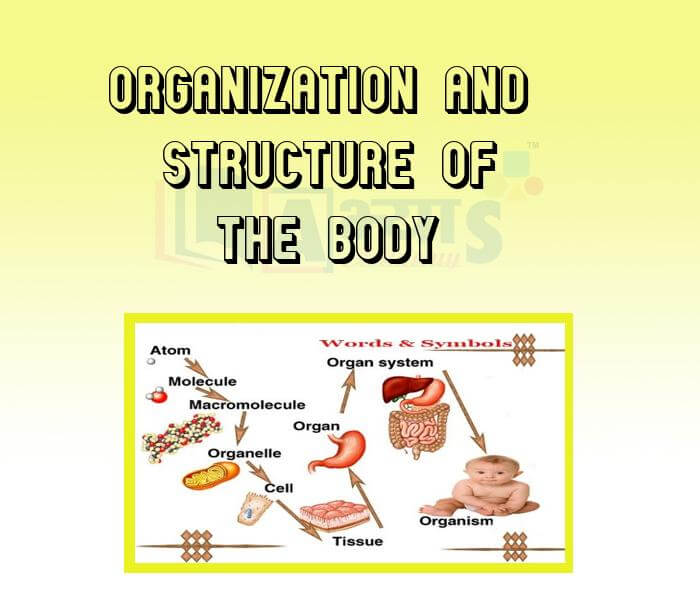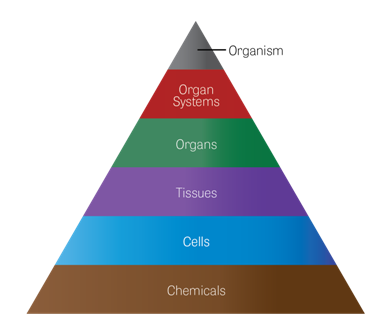Organization And Structure Of The Body









Organization And Structure Of The Body
All living things are made up of one or more cells. For this reason, cells are known as the structural units or the building blocks of life.
In an organism made up of only one cell (unicellular), the single cell performs all the activities necessary for life. In an organism made up of many cells (multicellular), the various life activities are performed by different groups of cell.
Organization of body :-
Cell :-
Cell is the smallest structural and functional unit of an organism. It is the building block of a living organism. It is a membrane bound and is made up of cytoplasm, genetic material and other cell organelles.
Tissue :
A group of cells that performs a special job together is known as a tissue. Blood, bone, muscle and skin are some of the tissues in your body. For example, muscle tissues are a group of cells, specialized to contract and expand for the movement of body parts.
Organ :
Tissues combine to form an organ. Each organ performs some important function of the body. For example, the heart is an organ that pumps blood to various parts of the body. The eye is an organ that enables you to see. Lungs, kidneys and liver are some other organs which perform important roles in your body.
Organ system :
Groups of organs work together to carry out various life activities in our body. For example the food pipe, stomach, small intestine, large intestine and some other organs together help you to digest the food you eat. Such a group of organs is called an organ system. The group of organs that carry out digestion of food collectively form the digestive system. Some other systems in your body are: circulatory, respiratory, nervous, urinary (or excretory), reproductive, muscular and skeletal system .
The main systems in the human body and their functions are given:
| ORGAN SYSTEM | MAIN ORGANS | MAIN FUNCTIONS |
| Skeletal system | bones | gives support to the body; protects internal organs; allow movement |
| Muscular system | muscles | movement of body parts |
| Circulatory system | heart, blood, blood vessels | transport nutrients and oxygen to all parts of body; transports waste |
| Nervous system | brain, spinal cord, nerves | controls all functions of the body |
| Respiratory system | nose, wind pipe, lungs | takes in oxygen and remove carbon dioxide gas |
| Digestive system | teeth, food pipe, stomach, small intestine, large intestine | Digest and absorb nutrients necessary for growth and maintainance of the body |
| Excretory system | kidneys,ureters,bladder, urethra, skin | removes waste from the body |
| Reproductive system | female : ovaries, oviducts, uterus, penis | produces offsprings |
All these systems together form your body. They all work to keep you alive. Thus, the human body, and the bodies of all multiceliular living organisms, are organized as follows:

Select the one that is incorrect about cartilage. | |||
| Right Option : B | |||
| View Explanation |
In which of these organ system do the males and females have different organs? | |||
| Right Option : D | |||
| View Explanation | |||
A group of cells specialized to perform a specific task is known as _____________________ | |||
| Right Option : A | |||
| View Explanation | |||
Students / Parents Reviews [10]
My experience was very good with Abhyas academy. I am studying here from 6th class and I am satisfied by its results in my life. I improved a lot here ahead of school syllabus.

Ayan Ghosh
8thMy experience with Abhyas is very good. I have learnt many things here like vedic maths and reasoning also. Teachers here first take our doubts and then there are assignments to verify our weak points.

Shivam Rana
7thIt has a great methodology. Students here can get analysis to their test quickly.We can learn easily through PPTs and the testing methods are good. We know that where we have to practice

Barkha Arora
10thOne of the best institutes to develope a child interest in studies.Provides SST and English knowledge also unlike other institutes. Teachers are co operative and friendly online tests andPPT develope practical knowledge also.

Aman Kumar Shrivastava
10thMy experience with Abhyas academy is very good. I did not think that my every subject coming here will be so strong. The main thing is that the online tests had made me learn here more things.

Hiya Gupta
8thAbhyas is a complete education Institute. Here extreme care is taken by teacher with the help of regular exam. Extra classes also conducted by the institute, if the student is weak.

Om Umang
10thIt was a good experience with Abhyas Academy. I even faced problems in starting but slowly and steadily overcomed. Especially reasoning classes helped me a lot.

Cheshta
10thBeing a parent, I saw my daughter improvement in her studies by seeing a good result in all day to day compititive exam TMO, NSO, IEO etc and as well as studies. I have got a fruitful result from my daughter.

Prisha Gupta
8thAbhyas Methodology is very good. It is based on according to student and each child manages accordingly to its properly. Methodology has improved the abilities of students to shine them in future.

Manish Kumar
10thAbout Abhyas metholodology the teachers are very nice and hardworking toward students.The Centre Head Mrs Anu Sethi is also a brilliant teacher.Abhyas has taught me how to overcome problems and has always taken my doubts and suppoeted me.
